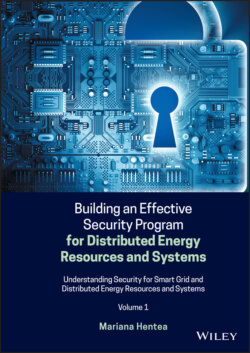Читать книгу Building an Effective Security Program for Distributed Energy Resources and Systems - Mariana Hentea - Страница 43
1.5.3 DER Information Systems
ОглавлениеAs DERs are used in the Smart Grid, a brief overview of DER systems helps security engineers and control engineers to understand the scope of DER tasks before planning for security protection. Examples of DER information systems (called also DER systems) that are used for DER operations and other tasks include the following:
Wide area situational awareness encompasses monitoring and display of power system components and performance across interconnections and over large geographic areas in near real time. The goals of situational awareness are to understand and ultimately optimize the management of power network components (including DERs), behavior, and performance, as well as to anticipate, prevent, or respond to problems before disruptions can arise.
Cybersecurity management encompasses measures to ensure the protection of information, control systems, IT systems, and telecommunication infrastructures that support DERs.
Network management includes monitoring, reporting, and control of communications; for example, DER systems use a variety of public and private communication networks, both wired and wireless; the identification of performance metrics and core operational requirements of different applications is also critical to the Smart Grid.
DR management and automation is focused on maximizing performance of DERs and PEVs; automation of distribution systems becomes increasingly more important to the efficient and reliable operation of the overall power system; the benefits of distribution management include increased reliability, reductions in peak loads, and improved capabilities for managing distributed sources of renewable energy.
Energy storage management systems include means of storing energy, directly or indirectly, data acquisition, controls of communications, and security protections.
Electric transportation refers, primarily, to enabling large‐scale integration of PEVs to increase use of renewable sources of energy.
Database management systems and the communication‐associated networks that create a two‐way network between advanced meters and utility business systems, enabling collection and distribution of information to customers and other parties, such as the competitive retail supplier or the utility itself; customers may be consumers and producers of energy (owners of renewable and storage systems).
The following are examples of DER information systems that can be included in the category of management information systems:
DR and consumer energy efficiency encompasses mechanisms and incentives for utilities, business, industrial, and residential customers to cut energy use during times of peak demand or when power reliability is at risk; DR is necessary for optimizing the balance of power supply and demand.
Information security management system supports the approach to developing, implementing, and improving the effectiveness of an organization’s information security with regard to the management of risk.
Other categories of information systems may include:
End‐user computing systems to support the direct hands on use of computers by end users for operational and managerial applications.
Business information systems to support the operational and managerial applications of the basic business functions of the organization, for example, integrated systems in Smart Grid.
Strategic information systems to support the operational and managerial applications of the basic business functions of the organization.
